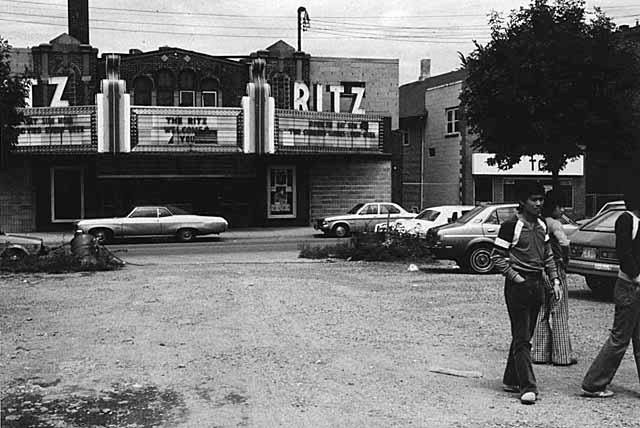HISTORY
In the heart of Northeast Minneapolis since 1926.
The Ritz Theater, circa 1940
Built in 1926 for a mere $45,000, Northeast Minneapolis was presented with the Ritz Theater. For nearly a century, the Sheridan and surrounding neighborhoods enjoyed everything from Polish films, movies, local theater, concerts, and much more as the Ritz Theater became an entertainment hub for local residents.
In 1935, just 9 years after its opening, the interior of the Ritz was given a modern remodeling to the tune of $15,000 by Dahlstrom and Weinberger with Art Deco flourishes by architect Perry Crosier.
The Ritz Theater Expands
In the late 1940s, in an effort to update the theater's heating and air conditioning systems, the Ritz Theater expanded with the construction of two additional buildings and a nearly full reconstruction of the building. "Workmen [tore] out the insides of the main building. When they finished only parts of the four walls and the roof remained," reported newspapers at the time of the $100,000 rebuild. It was at this time the building's front canopy (marquee) was extended and 500 feet of neon lighting as well as 500 light bulbs lit up 13th Ave. The Ritz Theater re-opened on Tuesday, Feb 22, 1949 after this extensive expansion.
Ritz Theater, December 9, 1953
The 1950s saw the remodeled Ritz Theater welcome theater-goers to see "First-Suburban showings," or movies that would first premiere in the larger theater houses of the Twin Cities, but come to local neighborhood theaters about a month later.
In 1960, the Ritz saw the return of all-Polish language films to its screen. Known prior to World War II as the home of Polish movies serving its predominantly Polish neighborhood, 1960 was the first year in which Polish films had been screened since the war. The theater continued as a movie theater until it was leased to the Cricket Theatre in 1971.
A news clipping from the Northeaster Newspaper, 1960.
Bill Semans, actor and founder of Cricket Theatre, began leasing the 900 seat Ritz Theater in 1971 as a performing arts space instead of a movie house.
The Cricket Theatre 1971-1978
In 1971, with a very real shift in the purpose of the Ritz Theater, Bill Semans, Minneapolis actor and producer and founder of the Cricket Theatre began leasing the Ritz as a new permanent home for his theatre company. The Ritz housed the theatre company, which began as a non-professional company, until 1978 when, due to a dispute with the landlord over rental rates, won a free year of rent at the location.
Later that year, the Cricket Theatre moved to the Hennepin Center for the Arts, now home to the Illusion Theatre. Read the original news clipping here.
Source: Hennepin County Library Special Collections
Bombing Damages the Ritz Theater
In the 1980s, the Ritz Theater returned to its roots as a neighborhood movie house. Sold to owner Sy Soo in November 1980, the former Ritz began showing predominantly Asian movies and drew a large number of Asian patrons and University of Minnesota students.
At 1:30am on the morning of August 17, 1981, police witnessed a car driving away from the Ritz Theater and an explosion, the result of a large pipe bomb that was thrown through a broken window in the theater's box office. Audiences had left the theater just an hour and a half before the bomb blew a two-foot-wide hole an inch deep in the concrete floor, heavily damaging the Ritz Theater lobby. The words "White Power" was scrawled in four-foot tall letters on the front sidewalk alongside a swastika.
Minneapolis police investigated the evidence citing recent outbreaks of Nazi literature and swastikas placed on the homes of nearby Asian Americans' homes. Area neighbors had expressed opposition to the theater's re-opening amid erroneous concerns that X-rated movies would be shown in the theater. Estimated damages to the theater totaled as high as $15,000. The Ritz Theater re-opened just a few days after the incident.
The Ritz Theater goes dark for more than a decade
From 1982 to 2000, the Ritz Theater's marquee remained dark. The theater, now empty, created disagreement over how the building would be used, or whether it should be torn down to provide parking for area businesses.
The Minneapolis Community Development Agency purchased the theater to acquire the parking lot when the Sheridan Neighborhood Early Learning Center was built in 1994 to avoid "severance damages" while splitting up the parking lot across the street from the Ritz.
In the mid 90s, sale of the theater was not a popular proposition due to concerns from neighborhood businesses and residents that the increased traffic and use of the building posed parking concerns along 13th Avenue.
At the time the Ritz Theater's fate would be determined, the theater sat empty with no heat, no utilities, no lighting, and had experienced severe leakage for several years. The estimated renovation costs totaling anywhere from $700,000 to $1 million to renovate the delipidated theater.
Ballet of the Dolls purchases the Ritz Theater
Mid 1990s, The Ritz Theater sat vacant for nearly two decades.
In 2000, the Minneapolis City Council approved a plan for the sale of the Ritz Theater to the Ballet of the Dolls dance company. The process of selling and renovating the Ritz Theater required the collaborative efforts of the Minneapolis Community Development Agency, who owned the theater, the Sheridan Neighborhood Organization, and the Minneapolis City Council, all of whom approved funding to aid in the renovation of the theater and its future use planning.
The Ballet of the Dolls intended the theater space to be used for theater, dance, rehearsal and public use space. Its avant garde dance styles presented an exciting use for the space with four to seven shows per season.
In 2005, the City of Minneapolis agreed to give the Ritz Theater to the Ritz Theater Foundation, after six years of leading the charge to restore the theater. After raising $2.2 million in funding from individuals, grants, foundations, neighborhoods, and the City of Minneapolis, the Ritz Theater's door were re-opened on May 16, 2006.
The Ballet of the Dolls remained the primary tenants of the Ritz from 2006 until 2014. Due to funding shortages in the renovation from the very beginning and without reserves set aside for the dance troupe, the future of the organization was unclear, but a new business model to rent the space to other area arts organizations led to its being nearly booked year-round, including the highly regarded theater company, Theater Latté Da.
Theater Latté Da buys historic Ritz Theater
The Ritz Theater proudly stands after exterior restoration work was completed in Fall 2017.
Theater Latté Da purchased the historic Ritz Theater in northeast Minneapolis on August 29, 2016. The company moved its administrative offices into the building in September 2014 and had been producing shows in the 245-seat auditorium since 2015. After producing shows for several years in the now-defunct Loring Playhouse, the company had been without a permanent performance space since 2006. The Ritz purchase meant that for the first time in the company’s 18-year history, Latté Da had administration, rehearsal and performance spaces in the same building.
The company, which specializes in reinterpreting musical classics and creating new musical theater, entered into an exclusive negotiating arrangement in March of 2016 with the Ritz Foundation, which owned the building.
“We will continue to deepen our relationship with northeast Minneapolis,” said artistic director Peter Rothstein. The Ritz is a fantastic building and we're thrilled to be part of its next chapter."
Ongoing exterior restoration, including tuck pointing and replacement of the theater's limestone capstones was completed in Fall 2017.
““The Ritz is a fantastic building and
we’re thrilled to be part of its next chapter.””









